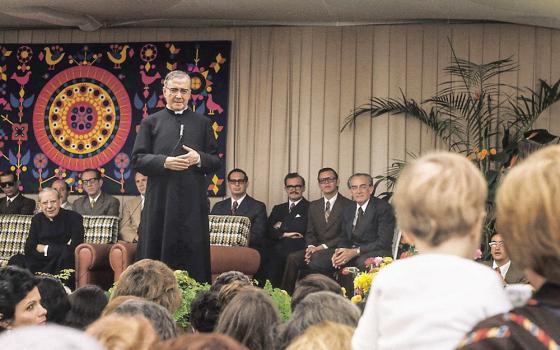Recently the Vatican was presented with the 2008 “Euro Solar Prize” for installing a giant bank of 2,400 solar panels atop the roof of the Paul VI Audience Hall, which began generating clean energy for the Vatican’s power grid on Nov. 26. Among other things, the award is a symbol of the strong environmental concern which has emerged as a distinctive element of the social teaching of Pope Benedict XVI, and which has become a cornerstone of the Vatican’s diplomatic efforts around the world.
On Saturday, Nov. 29, L’Osservatore Romano, the official Vatican newspaper, carried an essay warning that the current economic crisis is likely to aggravate the impact of environmental decay on the world’s poorest nations. Signed by veteran editorialist Francesco Valiante, the essay called for acknowledging a binding duty to protect the environment under international law, beyond a merely “moral” conception of environmental responsibility. The essay, titled "The 'Green' Heart of the Holy See," also floated the idea of a global eco-task force capable of galvanizing a rapid response to environmental catastrophes.
The following is an NCR translation of that essay, which appeared in Italian.
The “Green" Heart of the Holy See
By Francesco M. Valiante
Who’ll pick up the “ecological tab” for the current ecological crisis? It’s not hard to guess: Above all, it will be the weakest countries, those already penalized by environmental decay, who will see a further reduction in the green resources available on the global market. Fewer resources mean less clean energy and less clean technology. It means, in other words, dirtier water, more poisoned land, less healthy air. It means, in the end, less capacity to adapt to the consequences of climate change.
The “vicious circle of poverty and environmental decay,” denounced by the church for a long time, will only get worse.
In recent years, the church can take credit for keeping alive a high-level, comprehensive approach to ecology. The church hasn’t limited itself to offering criteria for a correct reading of the relationship between humanity and nature, but it’s also given an incisive contribution to the development of strategies for dealing with what’s been called the “environmental crisis.” The presence of a delegation from the Holy See at the Bali conference on climate change last year is a case in point, as is the Holy See’s ratification of the Convention of Vienna and the Protocol of Montreal on the protection of the ozone layer. The Vatican has also committed itself to giving a good ecological example within the limits of its own situation – exploiting alternative sources of energy, for example, utilizing recycling processes and compensating for its carbon emissions through reforestation.
In short, the Holy See has decisively chosen the path of realism, steering between alarmist scenarios and denial. On the debated question of climate change, it espouses a responsible vision of the “precautionary principle”: Even in the absence of absolute scientific certainties, it’s wise to take less optimistic scenarios into consideration, and therefore not to delay concrete choices and actions indefinitely, but to act now. The key point lies in an extension of the “responsibility of protection” to the environmental question, and, in particular, to care for the global climate.
This “responsibility of protection” was considered by the ancient ius gentium, the “law of peoples,” as the foundation for the actions of rulers with regard to their subjects. It was implicit in the origins of the United Nations, even if it’s only in recent years that it has been definitively recognized in that international setting. The principle has also been invoked in order to assert a duty to protect populations which have been the object of grave violations of human rights.
The Holy See has not only recognized this principle as an effective guarantee of “the unity of the human family and the innate dignity of every human being,” as the pope said at the United Nations this past April 18, but has also expressly extended it to the protection of the environment. In an important speech on Sept. 27, 2007, Monsignor Pietro Parolin, under-secretary for relations with states, affirmed that states have “a common responsibility of protecting the global climate and our planet,” in order to guarantee that “present and future generations can live in a safe and secure environment.”
If nations and international organizations were to take up this challenge, it could introduce some innovative elements into global conversation about the environment. While the current crisis prepares to present its burden to the most impoverished countries, [the church’s approach] could serve to revive the principle of interrelationship, according to which “the environmental question cannot be considered apart from issues surrounding energy and the economy, peace and justice, national interests and international solidarity,” as Archbishop Celestino Migliore, the Permanent Observer of the Holy See at the United Nations, recalled this past Oct. 28. It would also give renewed importance to the discussion over multilateralism, in a moment in which the temptation to allow particular interests to prevail over the common good is especially strong. The “responsibility of protection” should be the foundation of a consistent policy of sharing resources and technologies among rich and poor nations – a sort of “globalization of solidarity,” as Benedict XVI says.
This is not a time for fanciful initiatives or unilateral defections, which would undercut what Monsignor Parolin has defined as “a coordinated international political strategy, rapid and effective, capable of responding to such a complex question.”
Applied to the governance of the global climate, interrelationship and multilateralism would open new horizons – including the definitive rejection of a solely “moral” conception of the duty of environmental protection, which would instead be formulated as a true and proper juridical obligation. In order to fulfill this obligation, an original and active role should be attributed to the community of nations: one could hypothesize, for example, a trans-national agency of judgment and intervention – a sort of ecological task force – for great environmental catastrophes.
It’s not an utterly unrealistic prospect, if one thinks of the document from the 2005 global summit for the 60th anniversary of the United Nations, which spoke expressly of a “collective international responsibility to protect” with regard to crimes against the fundamental rights of humanity. Among those rights, shouldn’t the rights to health, an adequate diet and a dignified life also be included – rights which today are seriously compromised by environmental decay?




